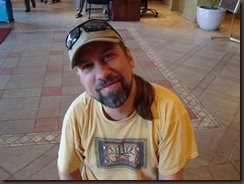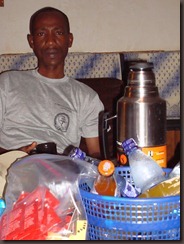 Traveling Again–Meeting up with Old Friends and New
Traveling Again–Meeting up with Old Friends and New
 Today began very early as we continued our journey to Kasulu. In the past we had flown from Dar, stopping in Tabora and then on to Kigoma in rather beat up Embre turbo prop planes. The whole trip took about 3.5 to 4 hours hours and was not very comfortable. That route is no longer available. With some trepidation we set off on our new route, flying to Mwanza and changing planes there after a 90 minute or so layover to go onto Kigoma. What an improvement! The flight to Mwanza was on a “short” Boeing 737 and only took an hour. We were on the right side of the plane which gave us some fantastic views on Mount Kilimanjaro.
Today began very early as we continued our journey to Kasulu. In the past we had flown from Dar, stopping in Tabora and then on to Kigoma in rather beat up Embre turbo prop planes. The whole trip took about 3.5 to 4 hours hours and was not very comfortable. That route is no longer available. With some trepidation we set off on our new route, flying to Mwanza and changing planes there after a 90 minute or so layover to go onto Kigoma. What an improvement! The flight to Mwanza was on a “short” Boeing 737 and only took an hour. We were on the right side of the plane which gave us some fantastic views on Mount Kilimanjaro.
After exiting the arrivals area, getting a taste of the Mwanza airport facilities (all open-air little cabana type shops), we re-entered initial security to get our boarding passes for Kigoma. In my previous experience, only in Dar did you get assigned seats. The outlaying airports would have “open” seating. The first onto the plane would grab all the window seats, making in very difficult to sit together….but what was this? Assigned seats? Cool! We boarded the terminal bus that drove us out to where our plane was waiting. There sat the familiar Embre turbo prop: passengers load from the back, the luggage and cargo area is between the cockpit and passenger area. But again, a very pleasant surprise: no beat up seats and interior – this was a very clean, new plane! The hour flight to Kigoma was a joy. Some great views of Lake Victoria on leaving Mwanza and super views of Lake Tanganyika before touching down on Kigoma’s clay/dirt runway.
Bill has posted pictures of the Kigoma arrivals (and departures) gate in the past. It’s always fun to see the folks waiting for the arriving passengers on the other side of the fence as you walk down the tin-roofed pathway. In this case it included a small flock of white-robed nuns excitedly awaiting the arrival of two sisters on our flight. We were greeted by our old friend, Emmanuel Bwata, our new friend, the rector of St. Michaels’s in Kigoma and our driver, Clement. All luggage was hand-delivered to the luggage window (the luggage handler often reading the names of the owners off of the luggage tags). We loaded it into one of the diocese’s rather beat-up but dependable Toyota Land Cruisers and headed into town.
Once again, another pleasant change: Five years ago, the road from the airport dusty, dirt, rutted and covered with trash. It is now clean and paved. Some work remains on the side gulley’s, which are obviously in progress. (Road gutters are really necessary here: imagine stepping into a shower under a “rainfall” shower head. That’s what it’s like when it rains here. Rain comes down fast and there needs to be somewhere for it to go.) We headed into town and then turned up off the paved road onto a series of washed-out eroded and wash boarded dirt roads which in the U.S. would be considered “off-roading”. We were delighted to arrive at the Hill Top Resort where we had lunch. Bill has spent several nights at this resort on past trips. The food is excellent and the view is fantastic. We caught up with our friends while we waited for our meal, which in Tanzanian fashion took a while to arrive.
Whenever anyone goes to Kigoma, errands must be run. Kigomo is more “big city” than Kasulu. It has had power for years and there are things you can get there that you can’t get at Kasulu. For years it was the last place where you can get cash from an ATM machine before heading to Kasulu. Our friends ran a few errands, we dropped the Rector of St. Michaels off at his church compound and started the hour an a half drive to Kasulu. This used to be a three hour drive. The road is now paved more than half way there. There are plans to pave it the rest of the way. Even most of the dirt portion of the road was relatively smooth – in the middle at least! As we got closer to Kasulu, the road become more rutted and wash-boarded.
The diocese compound is beautiful. It was originally built by German missionaries and often some German missionaries still live and work there. The gardens are both European and African in design and beautifully maintained. We are staying in the “German House” which is often used by the German missionaries. We have stayed here before and know how it “works” (when the water runs and doesn’t run; how to throw buckets of water down the toilet to flush it if necessary). It really is our home in Kasulu. Another improvement: the compound and the German house now has power 24/7! (The water is still an issue and it seems that the solar hot water system, which provided water even when to cold water was not running has been shut down as no one is currently living here.)
We met another new friend, Bishop Makaya’s wife, Editha, and a lovely young lady who brings us coffee snacks and heated hot water for our baths named Baysteela (phonetically spelled). Daudi Ndahana stopped by and had coffee with us. Eventually, dinner at the Bishop’s house with Mrs. Makaya and Emanuel Bwata and then home to the guest house with the sounds of night time Kasulu in the background.